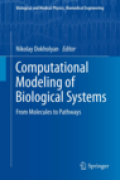
Computational modeling of biological systems: from molecules to pathways
Dokholyan, Nikolay
Computational modeling is emerging as a powerful new approach to study and manipulate biological systems. Multiple methods have been developed to model, visualize, and rationally alter systems at various length scales, starting from molecular modeling and design at atomic resolution to cellular pathways modeling and analysis. Higher time and length scale processes, such as molecular evolution, have also greatly benefited from new breeds of computational approaches. This book provides an overview of the established computational methods used for modeling biologically and medically relevant systems. Reviews established modeling approaches of biological systems across multiple length and time scales from molecules to cells. Covers recent and emergingcomputational techniques in modelling biological systems. Provides a fresh outlook on the topic by covering multiscale modelling and includes a section on molecular evolution. Can be used as a guide for selecting methods for studyingbiological systems. INDICE: Part I. Molecular Modeling. Chapter 1. Introduction to Molecular Dynamics: Theory and Applications in Biomolecular Modeling. Chapter 2. The ManyFaces of Structure-Based Potentials: From Protein Folding Landscapes to Structural Characterization of Complex Biomolecules. Chapter 3. Discrete Molecular Dynamics Simulation of Biomolecules. Chapter 4. Small Molecule Docking from Theoretical Structural Models. Chapter 5. Homology Modeling: Generating Structural Models to Understand Protein Function and Mechanism. Chapter 6. Quantum Mechanical Insights into Biological Processes at the Electronic Level. Part II. Modeling Macromolecular Assemblies. Chapter 7. Multiscale Modeling of Virus Structure, Assembly and Dynamics. Chapter 8. Mechanisms and Kinetics of Amyloid Aggregation Investigated by a Phenomenological Coarse-Grained Model. Chapter 9.The Structure of Intrinsically Disordered Peptides Implicated in Amyloid Diseases: Insights from Fully Atomistic Simulations. Part III. Modeling Cells and Cellular Pathways. Chapter 10. Computer Simulations of Mechano-Chemical Networks: Choreographing Actin Dynamics in Cell Motility. Chapter 11. Computational and Modeling Strategies for Cell Motility. Chapter 12. Theoretical Analysis ofMolecular Transport Across Membrane Channels and Nanopores. Part IV. ModelingEvolution. Chapter 13. Modeling Protein Evolution. Chapter 14. Modeling Structural and Genomic Constraints in the Evolution of Proteins. Chapter 15. Modeling Proteins at the Interface of Structure, Evolution, and Population Genetics.
- ISBN: 978-1-4614-2145-0
- Editorial: Springer New York
- Encuadernacion: Cartoné
- Páginas: 190
- Fecha Publicación: 28/03/2012
- Nº Volúmenes: 1
- Idioma: Inglés
